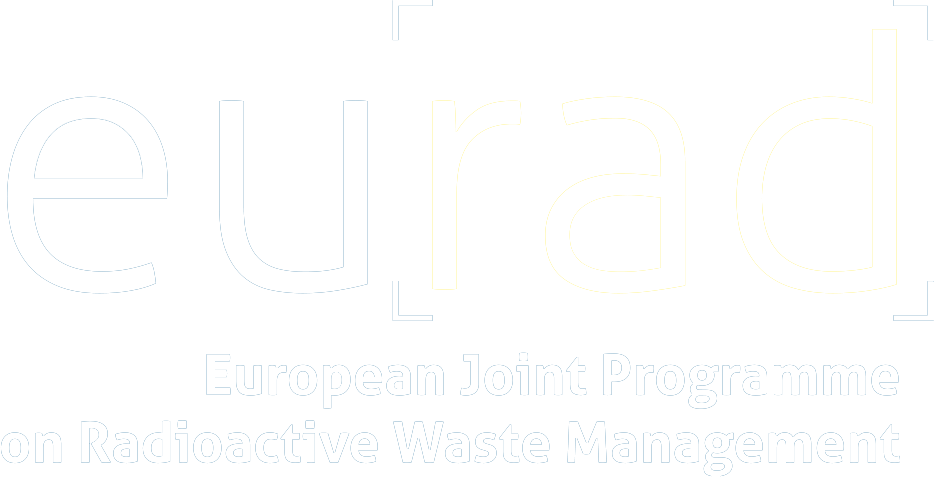
« Back to EURAD training course
- This item has passed.
Geochemical and Reactive Transport Modelling for Geological Disposal
February 6, 2023 - February 10, 2023
Background information
The geochemical evolution of the near field barrier system of a geological disposal is important in view of the safety and performance analyses of the repository as it will influence (i) the durability of the different materials, and (ii) speciation and mobility of radionuclides. Given the time scales involved (ten thousand to hundred thousand years), assessing the evolution can only be done with numerical models in which geochemistry is linked to transport, thus with reactive transport codes.
Geochemical models calculate geochemical state variables based on thermodynamic equilibrium and kinetic processes accounting for processes as aqueous speciation reactions, dissolution/precipitation based on saturation state, sorption based on mechanistic sorption models (exchange reactions, surface complexation) and possible kinetic processes (related e.g. to the dissolution of glass or clay minerals or the corrosion of steel canisters).Reactive transport codes typically couple these geochemical models to flow, heat transport and solute transport solvers. State-of-the-art reactive transport codes may couple this also the water flow or heat transport. Therefore, these codes are capable to simulate coupled thermal, hydraulic, chemical and biological (THCB) processes and possible feedback between the processes. They became a powerful tool for understanding and assessing these coupled processes and the consequences for containment.
Given the complexity of the system and the long-time scales, models typically have large computational times and many uncertainties associated with it. Recent developments in new couplings between different solvers, faster methods to solve equations including methods based on machine learning, and efficient algorithms for uncertainty analysis are crucial in the framework of the analysis of the long-term evolution, optimization and performance assessment of a radioactive waste repository.
In EURAD, the work packages ACED (Assessment of Chemical Evolution of ILW and HLW Disposal cells) and DONUT (Development and improvement of numerical methods and tools for modelling coupled processes) improve and implement codes and models for assessing the geochemical evolution in the near field of a repository. FUTURE develops further understanding in radionuclide migration. In view of that, this training will continue from the state-of-the-art and introduce the new developments acquire in these work packages.
Detailed description
Lectures on different topics related to geochemical and reactive transport modelling (provisional list)
Modelling geochemical systems – Thermodynamics, databases, reaction progress
Modelling slow processes (corrosion, dissolution, degradation)
Modelling properties and geochemistry of cementitious systems
Geochemistry of the host rock and natural barrier materials: Pore water, mineralogy, matrix-fracture
Speciation of radionuclides
Sorption of radionuclides
Reactive transport modelling
Uncertainty and sensitivity analysis
Use of model abstraction – surrogate modelling – machine learning in geochemical and reactive transport modelling
Hands-on on implementation of geochemical and reactive transport modelling (about 10 sessions). Based on two applications linked to ACED and FUTURE and are used in DONUT for benchmarking, participants will be trained in defining a conceptual model and implementing it in a geochemical and reactive transport code. The participants can chose from one of 3 codes based on GEMS, ORCHESTRA and PHREEQC – it is advisable to join the same code during the whole training. We will strive to have an equal distribution of the participants between the three codes. The two applications are:
Cementitious materials (ordinary Portland cement): database, hardening, geochemistry and other properties, chemical degradation/alteration, leaching or carbonation
Uranium sorption on clay materials: database, speciation, sorption to clay minerals, migration
Demonstration of other codes: during short lectures, an introduction to a number of other geochemical and coupled reactive transport codes that are used in the framework of radioactive waste disposal. Examples are CRUNCH, MIN3P, HYTIC/CHESS, CORE, OPENGEOSYS, OpenFOAM-PHREEQC, iCP (specific choices will depend on the availability of presenters)
Training aims
The training aims at enlarging knowledge and expertise in geochemical and coupled reactive transport modelling in the framework of disposal of radioactive waste with the focus on geological disposal. The theoretical basis will be enhanced by lectures on (i) principles of geochemical and reactive transport modelling, (ii) their applications for processes and evolution of materials in a geological disposal (cementitious materials, glass, steel, clay, granite) (iii) speciation and migration of radionuclides, and (iv) advanced topics related to uncertainty and machine learning. Practical skills will be improved by computer sessions in which participants will use available software to implement and analyze models for calculating properties and evolution of materials and speciation of radionuclides.
Learning outcomes
Upon completion of the training course, the participants should be able to:
Understand the principles of geochemical thermodynamic and kinetic modelling and reactive transport modelling
Use these principles for application in the field of radioactive waste disposal
Transform specific research questions related to geochemical properties or evolution into a conceptual model
Implement simple conceptual models into numerical codes for geochemical and reactive transport modelling
Identify advanced methods for sensitivity analysis, uncertainty analysis and integration of machine learning techniques
Training materials
Click here to download the training materials used in this training course.



